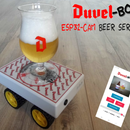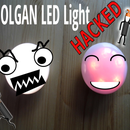Introduction: CCD Eyepiece for Binoculars
Have you ever looked through your binoculars and thought " I wish I could get this on tape" ? Well now you can. In this Instructable I'll show you how to build a cheap CCD eyepiece that will fit most binoculars.
You can use it with any camcorder that has a video input to capture whatever you can get a view on with your binoculars.
Step 1: Materials and Tools:
Gather the following, but note nothing is critical. Here and there I'll tel you how you could do it differently.
Tools:
saw, soldering iron, pliers, electric drill with hole saw, sharp knife, 4mm threading tool.
Materials:
- 1 cheapo binoculars (mine cost me +-8 euros, but they are quite good.)
- about 12 cm of PVC tubing , inner diameter must be a larger (1cm is ok) than binocular diameter. (I used 40mm diameter, 1.8 mm wall thickness, thicker is ok too).
- 6 nylon 4mm 12..20 long screws.
- RTV silicone or other adhesive.
- 1 CCD camera module. I used what I could get, which was a module cheap B&W module intended to go in a security camera. It cost me <20 euros. If you have the possibility use a color module with a decent number of lines, as this will give you a better result in the end.
-Some electronic components to power and attach the CCD module. This really depends on the module you can get.
Mine needed 5V, so:
- 78L05 Voltage regulator
- 10uF 16V capacitor
- 10uF 35V capacitor
- 220 ohm resistor
- red 3mm led.
- 1N4148 diode for protection against power-reversal,
- connector to go to a wallwart
- cable with video connector that matches the camcorder/monitor/videorecorder you want to use.
- a piece of perfboard.
optional: AA-size battery holder and switch, if you want a portable power source.
I couldn't find the exact datasheet of the CCD module I bought (they didn't even have it in the shop), but here is a datasheet of one that looks just like it, and had the same connections.
Incidently, you could do this hole thing also with a gutted webcam and use a laptop to record what you see through your binos, while you're on the road.
Attachments
Step 2: Construct the Tube:
Saw off three pieces of the PVC tube : one 10cm length, and two 1cm length. Remove burrs with knife.
Cut a piece out of the 1cm long tubes, so that if you push it together, it fits snugly in the 10cm long tube.
Take the 10cm piece, put 3 pencil marks at 120degrees on the circumference. draw lines along the tube on marks. put pencil marks at 5mm and 15mm from end of tube. Drill six 3.5mm holes.
Thread holes to 4mm using threading tool. Insert 6 nylon screws.
Actual dimensions depend on your binocular a bit, but take a look at the pictures, you'll see what I mean.
give it a try and fit the tube to the binoculars as in the picture.
Step 3: Assemble the CCD Module:
You want the CCD to be in the middle of the tube, therefore use a hole saw to cut a piece of perfboard a bit larger in diameter than the PVC tubing, then put a bolt through the perfboard and place it in the drill. Sand down on a file until it nicely fits the tube.
As already mentioned in step 1, the electronics depend heavily on the CCD module you have.
For my module, a 5V power supply was needed. I'm sure the world isn't waiting for another 78L05 schematic, but here it is, just in case.
The jumper labeled "gamma" on the CCD is there to switch between indoor and outdoor use.
Solder wires or connectors to the module. It's more or less up to you how you connect the module to the outside.
Try to get the CCD module as centered as possible on the perfboard, this will make alignment easier later on. Don't panic if you do not get it exactly in the middle: thats what the nylon screws on the tube are there for.
Next comes an important step: adjust the focus of the CCD. There's a small lens on top of it. On my module, I had to unscrew it almost completely to get it in focus correctly to a picture a few meters away on the wall. A drop of silicone adhesive keeps the lens in place.
Step 4: Assembly and Allignment:
Alignment is not that hard, once you know how to do it:
Place the tube on your binoculars, try to get it more or less in the centered, by adjusting the nylon screws.
Insert one of the short 1cm rings inside the long tube, but not to deep yet, you want approximately 2cm between top of the CCD and the lens of your binoculars.
Power up and connect the CCD module to a monitor or tv. Insert the CCD module and press it against the ring. Aim at something outside. Make sure upfront that the binoculars are in focus with the object you are taking into view.
If you're lucky, you'll see a bright spot somewhere in the screen. adjust the screws until the bright spot is in the middle, then take out the module, push the PVC ring inside the tube a few mm further.
Insert the module again, The spot should be larger, an might be a bit of center. Center again and repeat, until you have a complete bright image.
At that point the distance from the CCD to the binoculars is optimal. Take it out, put some silicone adhesive on the edge of the perfboard and insert. Then insert the second ring. Done.
Now go film something interesting and don't forget to rate!














